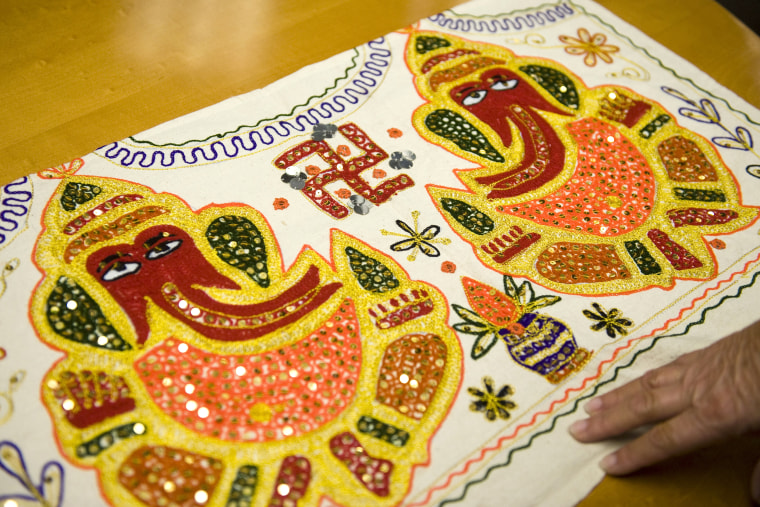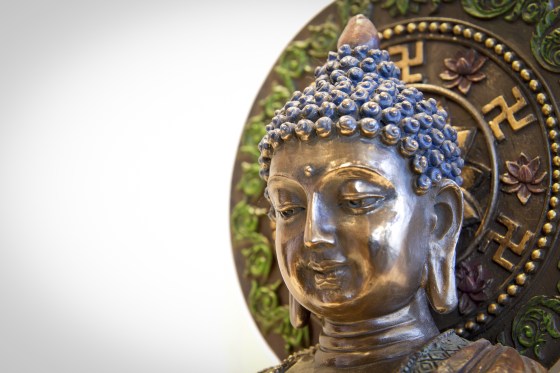During Nikhil Mandalaparthy's senior year of high school in 2015, the local Hindu temple in his hometown was vandalized. Spray-painted in red on the outside of the Bothell, Washington, worship and cultural center were the words “Get Out” — alongside a symbol that was almost familiar to the temple’s patrons: a swastika.
But the mark used to terrorize Mandalaparthy’s community was different than the swastikas he had grown up seeing in religious contexts. It was sharp and at a 45-degree angle, what he recognized immediately as a mark of Nazism and white supremacy.
The swastika, when softer, non-angled, left-facing or decorated with dots, has a very different meaning in the iconography of several Asian religions, where it has been ingrained for thousands of years. From Stone Age drawings in 10,000 B.C. to carvings in the ancient Greek city of Troy, swastikas were used on virtually every continent as a symbol of good fortune.
The swastika has a particularly strong presence in Hindu, Buddhist and Jain communities across the world. In paintings and sculptures, it can be found on the palms of the Buddha’s hands, on Jain and Hindu temples, and in designs in the traditional powder art form of rangoli. But beyond that, it pops up regularly in everyday life — on taxicabs, food packages and clothing in countries such as India, Japan, Nepal, China and Sri Lanka.
But as the Asian diaspora continues to grow, the two versions of the swastika have begun to meet more frequently in the West. The religious symbol, meaningful to communities in their art and worship, is often confused with the hate symbol twisted by the Nazis into a mark of white supremacy.
National reckonings about race, religion and ethnicity in the last few years have brought conversations about racism and xenophobia to the fore. And a renewed effort by some leaders to ban the swastika has been met with questions from Asian communities who say there need to be exceptions.
After Canadian Prime Minister Justin Trudeau denounced "people who wave swastikas" as part of the trucker protests last month, Parliament member Chandra Arya addressed his colleagues on the subject. Arya called attention to the distinction between the Hindu swastika and the Nazi symbol, asking that the public and officials know they both exist.

Similar conversations have happened in Australia, where a state recommended a ban on swastikas, while adding protections for religions that have long employed the symbol. Germany, Hungary and France, among others, have completely banned the Nazi symbol, with exemptions for religious swastikas, plus those used in art and education.
“I don’t think the answer is just to delete it and to stop using that symbol,” said Mandalaparthy, 24, who works as an organizer with the progressive organization Hindus for Human Rights. “But I do think in the United States and other countries in the West, there is sensitivity that’s needed where more people recognize it as a symbol of Nazi ideology than one of our South Asian religions.”
I don’t think the answer is just to delete it and to stop using that symbol."
sNIKHIL MANDALAPARTHY said
A middle school across the street from his temple was vandalized that same day with a more specific message — “Get out Muslims.” The attack seemed to be misdirected Islamophobia, and it was one of Mandalaparthy’s first encounters with racism in his Seattle-area suburb. Though it was scary, he says, there was an irony in the swastika being weaponized against local South Asians at their place of worship — with a symbol which stemmed from something that was historically theirs.
“It’s like, you know, we have swastikas inside too,” he told NBC Asian America.
A once-global symbol
Predating the Christian cross, the four-pronged swastika’s roots are ancient. Experts say that though Asia was its main home, the symbol was at one time global.
“There have been swastikas found in ancient civilizations from the Americas to Greece and the Mediterranean, in China, even in ancient synagogues,” said Brandon Bloch, an assistant professor of history at the University of Wisconsin-Madison who studies religion, politics and 20th-century Germany.
Scarred from Nazi use, the symbol has largely disappeared from use in the West, but in South Asia, it shows up in everyday life.
In Hindu philosophy, some say the swastika represents the four Vedas, ancient Sanskrit scriptures. The version of the symbol generally used in India is the right-facing swastika; the birthplace in Porbandar, India, of the Indian independence leader and social reformer Mohandas K. Gandhi, widely known as Mahatma Gandhi, is marked with one.
In Buddhism, it’s closely associated with the Buddha, sometimes marked on his body in statues and ingrained into the designs of temples. After World War II, Buddhists outside India almost universally opted to use left-facing swastikas instead of right-facing ones. They can be found sewn into clothing and on food packages. For Jains, the prongs of the emblem represent the states of existence and the universe as cyclical.
“If you go to a drugstore in India, you can buy aspirin or something to take for a hangover and it’ll have a swastika on it,” said William Elison, an associate professor of South Asian religions at the University of California, Santa Barbara. “In Hinduism, there’s an association with the sun. ‘Swastik’ in Sanskrit means lucky or auspicious.”
Historians say the use of the swastikas by the Nazis represents just a small fraction of the symbol’s ancient use. German race scientists spent the 18th and 19th centuries theorizing about the roots of an Aryan or “pure” people stemming from Persia and branching to Europe and North India, a racist basis upon which Nazis perpetuated genocide during the Holocaust.
“For the Nazis, the swastika was a symbol of this Aryan race,” Bloch said. “The roots of this ‘superior German race’ in Indo-Aryan culture they trace back to ancient India, which they think distinguishes them from the so-called Semitic race that the Jews come from.”
The swastika was co-opted as part of this white supremacist pure-race mythology, and with the rise of nationalism in 19th century Germany, the symbol began to appear in radical and occult circles in the country. When the Nazi party came to prominence after World War I and those extremist groups came to power, the swastika came with it. By the time Adolf Hitler became a political leader, Bloch said, the German swastika and the concept of Aryanism were completely divorced from any connection to the Indian subcontinent they once had.
In the decades that followed World War II, the co-opted version of the swastika broadened beyond Nazism, and in the U.S. is now considered an emblem of white supremacy.
All the while, the Asian diaspora has grown rapidly in the Western world, bringing with it religious institutions such as temples, monasteries and mosques. As with Mandalaparthy’s childhood temple, third-culture children grow up simultaneously explaining and being attacked with a symbol that was theirs to begin with.
“Hindu communities in this country encounter this problem of, 'Oh, but wait, ripped out of one context and brought into another, people who do not have that set of Asian cultural, artistic and religious associations, they see it as something totally different,'” Elison said.
Is it possible to reclaim the swastika?
Sravya Tadepalli, who works as a board member of Hindus for Human Rights, has long spoken out against attempted blanket bans of the swastika. As part of a 2020 initiative called “Every Student Belongs,” the Oregon Department of Education issued guidance banning hate symbols in public schools. Among the symbols mentioned in the original rule were the Confederate flag, the noose and the swastika.
"We definitely supported the banning of the Nazi swastika, but if you look at the two symbols, they are different."
Sravya Tadepalli said
When Hindus in the community became aware of the ban, Tadepalli organized a letter-writing campaign encouraging the department to consider an exception for the religious symbol.
“We definitely supported the banning of the Nazi swastika, but if you look at the two symbols, they are different,” she said. “They’re different alignments, they’re different colors, and the Hindu swastika generally has dots.”

Eventually, the department’s ruling was revised with added language differentiating between the two. But in her campaign, Tadepalli says, she took the advice of community leaders across faiths, ensuring that the exception wouldn’t put any marginalized groups at risk.
“This is about protecting all minority religions,” she said.
In the same temple that was vandalized by swastikas when he was in high school, Mandalaparthy remembers a sixth-grade field trip that spurred a discussion about the symbols on the inside.
“I remember kids commenting and being like, ‘That’s a swastika, that’s a Nazi thing’ and having to explain, ‘You know, there is a difference and this one is for good luck,’” he said.
It wasn’t a vitriolic conversation, he said, and it’s one Hindus should have with thoughtfulness for the communities that would find the symbol jarring. When it comes to the questions of whether or not Asians can reclaim and display it, activists say interfaith dialogues are key. But it also just comes down to common sense.
“If there’s, for example, a Hindu-Jewish interfaith event, and we’re designing a poster, just having the sensitivity that, maybe instead of a swastika, let’s just use an 'Om,'” Mandalaparthy said, referring to another sacred Hindu symbol.
Spearheading parallel conversations about the use of the swastika are right-wing Hindu nationalist groups who progressive advocates say use symbols like it to push an extremist political agenda that oppresses minority religions in India. In Tadepalli’s work with Hindus for Human Rights, she says, she’s made a point of steering away from those organizations and their talking points, as well as bringing Muslim and Jewish people into the dialogue.
“Having these conversations with the religions that are affected and making sure that their voices are heard equally, is really, really important,” she said. “And also never framing it as like Hindu-phobia. We want to treat all minority religions equally.”

